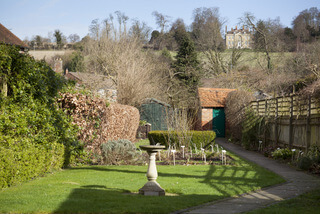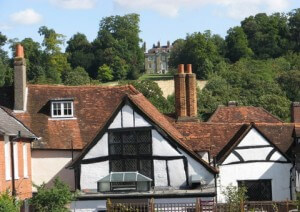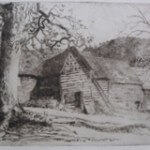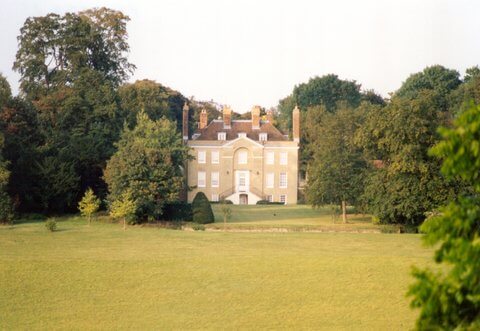 The Old Rectory was built in the 1730s by Reverend Benjamin Robertshaw. It was often the second son of the Lord of the Manor (a member of the Drake family) who was appointed as the Rector. The Rectory was sold in 1963 and has been a private house since then. Rectory Meadow, below the house, was in the past was used for fetes and tobogganing – before the local Health Centre opened at the foot of the meadow in June 1989.
The Old Rectory was built in the 1730s by Reverend Benjamin Robertshaw. It was often the second son of the Lord of the Manor (a member of the Drake family) who was appointed as the Rector. The Rectory was sold in 1963 and has been a private house since then. Rectory Meadow, below the house, was in the past was used for fetes and tobogganing – before the local Health Centre opened at the foot of the meadow in June 1989.


Click to find out about the cricketing Rectors of Amersham.
Click to read how Rector Briggs asked for a lift on a boy’s toboggan.
The article below by Dr Michael Brooks was published in the Amersham Society/Amersham Museum newsletter and is reproduced with permission.
The Rectories and Parsonages of Amersham
In 1140 Amersham Church with its glebe land and the advowson, was bestowed by Geoffrey de Mandeville, 1st Earl of Essex, on the Abbey of Walden in Essex as part of its endowment of that new establishment. The newly built Norman stone church was dedicated to St. Mary replacing a Saxon church thought to have been on the same site. The names of the earliest clergy are unknown but the Cartulary of Missenden Abbey records Herbert as “clerico de Augmodesham” in 1187 and his successor, Hugh, as “chaplain of Amersham” ca.1200. The first mention of a Rector came with the appointment of William de Fauconbridge by Walden Abbey in 1222.
Where did these rectors live? As the rectors were in receipt of the tithes and income from the glebe land, their income in Amersham was greater than in any other parishes so that the living was regarded as a very appropriate gift for Court Clerics, Bishops, Archdeacons and Canons, many of whom never actually lived in the town. For example William Grey, son of Richard, 4th Baron de Grey of Codnor, was officially rector from 1437 to 1454, but during those years he was Chancellor of Oxford University from 1440 to 1442 and then King Henry VI’s Proctor in Rome from 1445 to 1454. He only resigned the rectorship when appointed Bishop of Ely in 1454. The church here would however have provided some suitable accommodation. In 1535 the church revenue is recorded as being £48.16s. which figure included ‘a parsonage house’ – another name for a rectory. No description of that house has been found though it is thought that it was on a site to the north of the later 16th and 18th century rectories on what is now Rectory Hill.
The earliest description of a rectory is to be found in a terrier of all the possessions of rector Robert Challener dated 20th September 1607. He had been presented to the Amersham living by the 2nd Earl of Bedford on 20th June 1576 and is fondly remembered for having, by the terms of his will, established the Grammar School. He lived in a rectory here in 1603 as a letter from Ann Clifford, Countess of Dorset, Pembroke and Montgomery relates how she “lay at Dr. Challener’s being in Amersham”. The terrier of 1607 describes “a Dwelling house of 16 bays built with Tymbre and covered with tyles being chambred and boarded and disposed into necessarye romes and two storeys”. Unfortunately no date of building is to be found but that it was a large and impressive house is confirmed by a Poor Rate assessment of 1662 when it was valued more highly than either Shardeloes Mansion or Bury Farm, the local Manor House.
In 1621 on the death of Dr Challener, Charles Croke succeeded as rector and lived in the Rectory. As a Royalist who had been Chaplain to King Charles I and as Amersham was a parliamentary town, he had to keep a low profile and supplemented his income by taking in pupils including William Drake. He survived into the Commonwealth but retired to Ireland when the Book of Common Prayer was banned by the Puritans. Puritan Edward Terry and then Presbyterian John Phillips succeeded but the latter was evicted for simony (buying and selling ecclesiastical preferments) at the restoration.
King Charles II appointed Thomas Crawley to be rector in 1661, but John Phillips still lived in the Rectory up to 1662 when he was evicted, taking the Court Rolls with him, which were unfortunately never recovered. Thomas Crawley was also the rector of Barton-in-the-Clay where he lived until his death and burial there in 1677. It is doubtful whether he ever lived in Amersham Rectory which suffered much neglect during the Civil War and the Commonwealth, and even then it was described as “an old house, rambling and shamefully out of repair”.
Josias Smith, appointed to the living by William Drake in 1677, was buried in Amersham in 1702. He may have lived in the Rectory but increasing complaints to church authorities during the last quarter of the 17th century led to preparation of a detailed inventory, which stated “It contains 22 roomes. 11 roomes on ye first flower, 6 paved with brick, 3 flowered with deal, 2 with earth; and 11 roomes on ye upper flower, 3 flowered with oack, 2 whith deal, 4 with Elm and onn whith beach”. No attempts at repair can be found in the church records. Humphrey Drake (no relation to the Shardeloes Drakes) who was curate here in 1697, became rector in 1702 but was at the same time Rector of Grafton Regis in Northants from 1698 to 1721. He never occupied the Rectory which was let out to a John Bell in the early 1700s, although Rector Drake must have spent some time in Amersham, as he was buried here on 18th November 1721.
Hon. Henry Brydges, son of 8th Baron Chandos and brother of the 1st Duke of Chandos, was presented with the living by Montague Garrard Drake in 1721. He was obliged to rent Raans Farm from William Proby for £60 per annum because of the dilapidated state of the Rectory. The autobiography of his successor Benjamin Robertshaw states that Dr. Brydges talked about building a new parsonage, but that his family was too numerous “having seven or eight children and no estate but what came to him by his lady”. Rector Brydges became a Canon of St. Paul’s in 1722 and died in Bath in 1728 at the age of 84, having fathered 13 children! Robertshaw also states of Dr. Brydges “nor did he ever lay out one shilling repairing it in above seven years that he held the living. I might have recovered a great sum of his widow for Dilapidation but my heart wou’d not yield to bring ye widow and children of my dear good friend, who loved me as his brother, into any kind of distress”. The revenue from the glebe and tithes in 1728 had been £1,500, a considerable sum, so Dr. Brydges might have been expected to have made some repairs to the old Rectory, but with the revenue came Manorial responsibility and as effectively landowner the rector would have had to exercise rights and duties towards the locals as Lord of the Manor. So for more than fifty years the Rectory was just left to rot. It was Benjamin Robertshaw who built the splendid Georgian Rectory which graces Amersham to this day. Robertshaw had been appointed Master of Dr. Challener’s Grammar School in October 1702 and curate to Dr. Brydges that same year. He was priested in 1703 then became curate at Chalfont St. Giles and then Vicar of Penn in 1716. He was presented to the living of St. Mary’s in 1728 by the Trustees of Montague Garrard Drake, who died that year leaving a seven year old son. In his autobiography Robertshaw recalls “In ye year 1732 I began building ye parsonage house and finished it in less then 3 years, tho’ I did not remove from the town to live in it till Lady Day 1736. The front of it stood where ye upper wall of ye garden now stands, and ye Hall adjoyned to those two rooms which I had left standing and repaired for an infirmary or a garden house or for a poor man to live in”. Rector Robertshaw was a capable and diligent man who sorted out much neglect in the Parish left by previous rectors. He died in his beloved Rectory in 1744 and is buried in St. Mary’s Church.
The water supply for Robertshaw’s Rectory and its predecessor was a 52 ft. deep well. Monuments of Bucks. (1912) described the well house as “now disused.. timber-framed with brick filling. Probably 17th century. Roof originally had king-post trusses and cambered tie-beams with curved braces. The turning post is fixed to the trusses. It was formerly worked by a horse and has a double-grooved drum at the top of the chains”. In some of our records it is described as a donkey-well and it was still in use up to the early 1900s. There is an etching of Rectory barn (see above) and one of this well by William Monk in Amersham Museum, showing a horse at work.
The Rectory was further embellished by Samuel Wyatt between 1775 and 1785 when he was working at Shardeloes Mansion and also at St. Mary’s Church, when John Drake was the rector. From 1753 until 1904 the living of St. Mary’s was held by a member of the Drake family, except for a short period from 1860 to 1863 when Robert Kingdon held the post.
The field extending down to the town from the Rectory became known at the end of the 18th century as the tenterfield. A cotton mill was in operation in Amersham from 1786 to 1809 and the names of the cotton workers may be found in the Parish Registers. Cloth from the mill was hung out to dry on tenterhooks. During the 19th and 20th centuries the field was used by local children for tobogganing. The lawn at the top of the field in front of the Rectory was used by the rectors for fêtes and garden parties and on one occasion in 1913 for a religious pageant. In 1908 a two-day bazaar was held there in aid of St. Mary’s Church Restoration Fund.

By the late 1950s it had become obvious that the Rectory was too large and expensive to maintain. In 1956 Rector Thomas Horsman South approached the Dilapidations Board for permission to sell the Rectory and to allow an application to build a new rectory on church land. This was at first refused, but after he left in 1963 (to be Rector of Latimer and Flaunden and later Rural Dean and Canon) the Rectory was vacated and the issue was again brought to the attention of the church authorities. It was estimated that essential repairs and improvements would cost at least £10,000. A temporary rectory was established at Beaumont, Hervines Road, which was outside the Parish. It was decided that the Georgian Rectory was no longer viable and in 1963 it was sold to Robert Constantine, a shipping magnate for a sum rumoured to be £25,000. He was able to begin major restoration to the lovely old building.
A new rector, Allan Campbell, was appointed in 1963 after the sudden withdrawal of another appointee. He lived at Beaumont. Rector Campbell and the PCC pushed for a new rectory to be built within the Parish on glebe land to the east side of the church. It was hoped to sell Beaumont to help to fund this. After ten years the Sir Basil Spence Partnership was asked to draw up plans, the estimated original cost being £113,821. Not everyone approved of the use of Church Mede as it had never been built upon, except possibly as the site of a mediaeval mill. Serious vandalism of windows in St. Mary’s served to encourage approval of the plans by the Parsonage Board, as the proximity of a new rectory might discourage such behaviour.
Finally, after 22 years, construction of the new rectory began on the 22nd April 1985 on part of Church Mead. The architect for the building was Patrick Ettwein who was then working in the Sir Basil Spence Partnership. The roof design was conceived as a response to the context of the materials and vernacular design in the town. Ettwein was constrained by diocesan green book regulations stipulating size and floor area of new rectories, and parish records contain a series of designs and plans as problems arose over orientation, surrounding walls and provision of services to the site. His final design left considerable wasted space behind the walls on the first floor, with much inaccessible roof space. His original garage was integral to the house, but designed to be turned into a room at some future date, which did in fact happen.
The first occupants of the modern rectory were Anthony Priddis and his family in 1986 when Anthony was appointed Priest in Charge. He became Rector in 1990 and has fond memories of his time there.
One thing he did not care for was the colour of some floorboards which had been painted in vivid gaudy colours by David Smith; Anthony and the family had to turn to and repaint them dark brown. Anthony left to become Bishop of Warwick in 1996 and later he became the Bishop of Hereford. Revd. Tim Harper succeeded Anthony as Rector in 1997 and still lives in the Rectory.



